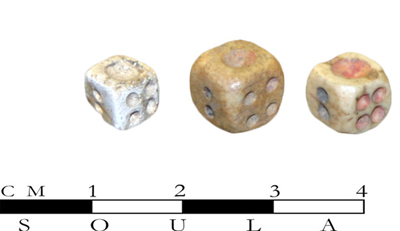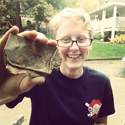Digging Jacksonville – February 2015
In October, 2013, the Southern Oregon University Laboratory of Anthropology (SOULA) excavated a Chinese house in the historic Chinese Quarter of Jacksonville which burnt down in 1888. During the excavation, a large and rich artifact assemblage was recovered, which included seven bone dice, along with other gaming paraphernalia. A single bone dice was also recovered along California Street during a 2004 excavation.
As an anthropology student involved with SOULA, I had the opportunity to clean and analyze the collection of dice found in the 2013 assemblage. Information gathered from these dice was also shared with a scholar from UC Davis, who is using them in his research on dice from around the world. The seven Jacksonville dice range in size from .25 inches to .33 inches, making them smaller than what we are familiar with today. All the dice have their numbers oriented with the one across from the six, the two across from the five, and the three across from the four, like modern European dice. The One is much larger than the other numbers, and on four of the dice it is painted red along with the Four side. The rest of the dice do not have any of the numbers painted red, or they were too damaged to tell.
These dice would have been used both to play traditional Chinese and Euro-American dice games. These games were used as a way for Chinese immigrants to socialize with each other, and interact with the larger, Euro-American, community in Jacksonville. Gaming was not only a social activity for the Chinese immigrants in Jacksonville, but also a profession. The 1870 Jacksonville Census recorded seven Chinese men as having the occupation of “gambler.” Their ages ranged from 24 to 52 and three of the seven had a personal estate listed of between 200 and 400 dollars, which today equates to between $3,500 and $7,100. These men would have played dice or other popular gambling games in either a gambling hall or the back room of a store. Both Euro-American and Chinese patrons would have frequented these establishments.
These seven dice provide insight into the often overlooked social, leisure, and economic aspects of the daily lives of Chinese immigrants in the nineteenth century American West. While history books frequently glorify the Wild West with stories of gambling cowboys, the social activities of the minorities in the community are often omitted or vilified. Archaeological assemblages, like the one found in the Chinese Quarter, help us to better understand the lives of the many undocumented people living in Jacksonville during the nineteenth century.
To find out more about archaeology in the Jacksonville Chinese Quarter you can check out a display running all month in the Jacksonville Library, and hear a talk about the research Saturday, February 7th at 1:00pm in the library’s Naversen Room.
Excavations in the Jacksonville Chinese Quarter were funded by the Oregon Department of Transportation and the City of Jacksonville.

 Sage King is a McNair Scholar and graduated Magna Cum Laude from SOU in December of 2014 with her B.S. in Anthropology. She did her senior thesis on a collection of gaming pieces, including the dice, recovered from the Jacksonville Chinese Quarter Site in 2013.You can reach SOULA by contacting Chelsea Rose at rosec@sou.edu and follow SOULA on
Sage King is a McNair Scholar and graduated Magna Cum Laude from SOU in December of 2014 with her B.S. in Anthropology. She did her senior thesis on a collection of gaming pieces, including the dice, recovered from the Jacksonville Chinese Quarter Site in 2013.You can reach SOULA by contacting Chelsea Rose at rosec@sou.edu and follow SOULA on